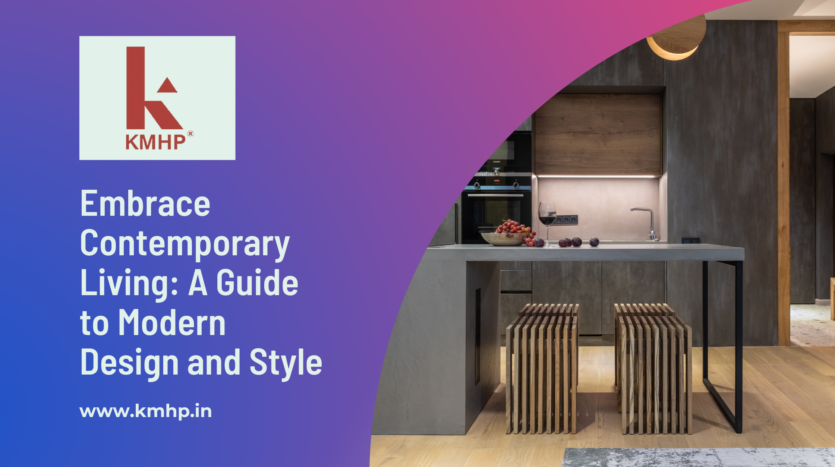Welcome to our comprehensive guide on embracing contemporary living through modern design and style. In today’s fast-paced world, the concept of modernity has become synonymous with simplicity, functionality, and a harmonious blend of form and function. Whether you are looking to transform your home or simply incorporate elements of modern design into your living space, this article will provide you with valuable insights and practical tips. From understanding the key principles of modern design to exploring the elements of contemporary style, we will delve into topics such as minimalism, open floor plans, natural light, technological integration, furniture selection, and adding personal touches. Join us on this journey as we navigate the intricacies of modern design and help you create a living space that reflects your unique personality while embracing the essence of contemporary living.

Understanding Modern Design: Key Principles and Concepts
The Evolution of Modern Design
Modern design has come a long way from its roots in the early 20th century. Initially, it emerged as a response to the ornate and heavily decorative styles of the past. Designers sought to simplify and streamline their creations, focusing on functionality and efficiency. Over time, modern design has evolved to embrace new materials, technologies, and cultural influences, resulting in a more diverse and dynamic aesthetic.
Embracing Simplicity and Clean Lines
One of the key elements of modern design is its emphasis on simplicity. Clean lines and minimal ornamentation are the hallmarks of this style. Furniture and architectural elements are often sleek and uncluttered, creating a sense of openness and ease. By eliminating unnecessary embellishments, modern design allows the beauty of form and function to shine through.
Incorporating Functionality and Practicality
Modern design places a strong emphasis on practicality and functionality. Every element of a space or object is carefully considered to ensure it serves a purpose. From multifunctional furniture to clever storage solutions, modern design seeks to optimize the use of space and enhance daily living. This focus on practicality makes modern design not only visually appealing but also highly livable.
Exploring the Elements of Contemporary Style
Use of Neutral Colors and Monochromatic Schemes
Contemporary style often favors a neutral color palette, consisting of shades such as white, beige, gray, and black. These colors create a calming and harmonious backdrop that allows other design elements to stand out. Monochromatic schemes, where different shades of the same color are used, can also be found in contemporary design, adding depth and sophistication to a space.
Playing with Textures and Contrasting Materials
To add visual interest and depth, contemporary design incorporates various textures and materials. A blend of smooth and rough surfaces, such as glossy finishes paired with natural or textured materials, creates a compelling contrast. This interplay of textures adds dimension and tactile appeal to the overall design, making the space more engaging and inviting.
Incorporating Geometric Patterns and Shapes
Geometric patterns and shapes are a common feature in contemporary design. From bold stripes to intricate polygons, these patterns bring a sense of order and structure to a space. Geometric shapes, such as squares, rectangles, and circles, are also prevalent in furniture and architectural elements. Their clean lines and precise forms contribute to the sleek and modern aesthetic.
Incorporating Minimalism: Simplifying Your Living Space
Decluttering and Organizing Your Home
Minimalism is a popular approach within modern design that promotes simplicity and clutter-free spaces. To embrace minimalism, start by decluttering and organizing your home. Remove unnecessary items and keep only what you truly need or value. Streamline your belongings and find storage solutions to maintain a clean and uncluttered environment.
Optimal Furniture Placement for a Minimalist Look
When arranging furniture in a minimalist space, focus on functionality and visual balance. Opt for furniture with simple lines and a compact design. Place larger pieces against walls to create open pathways and allow for a sense of spaciousness. Keep the arrangement minimal, allowing each piece to have breathing room and maintaining a clutter-free aesthetic.
Maximizing Storage Solutions in Minimalist Design
In minimalist design, storage solutions play a crucial role in maintaining an uncluttered space. Look for furniture pieces with hidden storage compartments, utilize wall-mounted shelving, and take advantage of under-bed or vertical storage options. By maximizing storage solutions, you can keep your essentials organized and out of sight, contributing to a clean and minimalist environment.
Embracing Open Floor Plans: Creating a Sense of Space
The Benefits of Open Floor Plans
Open floor plans have become increasingly popular in modern design due to their many advantages. By eliminating walls and barriers between different areas of the home, open floor plans create a sense of spaciousness and connectivity. They also allow for more natural light to flow throughout the space, enhancing the overall ambiance and making it feel airy and welcoming.
Designing Flow and Cohesion in Open Spaces
When designing an open floor plan, it’s essential to create a sense of flow and cohesion between different areas. Consistency in materials, colors, and design elements helps tie the space together. Thoughtful placement of furniture and use of rugs or lighting fixtures can define distinct zones while maintaining visual continuity. By designing with flow in mind, you can ensure a harmonious and functional open space.
Creating Functional Zones within an Open Floor Plan
While open floor plans offer flexibility, it’s important to define functional zones within the space. By using furniture, area rugs, or architectural elements, you can visually delineate different areas such as living, dining, and kitchen spaces. This creates a sense of purpose and organization while maintaining the open and connected feel of the overall design.a Personal Touch: Infusing Personality into Modern Design
Incorporating Art and Personal Collections
Mixing Patterns and Textures for Visual Interest
Embracing Quirky and Unique Design Elements
———————————————————————————————————————
Incorporating Natural Light and Indoor-Outdoor Living
Harnessing Natural Light for a Brighter Space
When it comes to modern design, natural light is your best friend. Not only does it make a space feel brighter and more inviting, but it also has numerous health benefits. So, throw open those curtains, embrace the sunshine, and let the light flood in. To harness natural light effectively, consider installing large windows or floor-to-ceiling glass doors that allow for maximum sunlight penetration. You can also opt for skylights or light tubes to bring in additional light, especially in areas with limited access to windows. Remember, natural light can transform a room, making it feel more spacious and airy. So, don’t be afraid to embrace it and let the sunshine in!
Creating Seamless Transitions between Indoors and Outdoors
Gone are the days of strictly defined indoor and outdoor spaces. Modern design blurs the boundaries between the two, creating a seamless flow from inside to outside. To achieve this, consider incorporating large glass sliding doors that open up to a patio or garden area. This creates a connection between your interior living space and the natural world outside. You can also extend your living space outdoors by adding a cozy seating area or outdoor kitchen. By blending indoor and outdoor spaces, you not only increase your living area but also create a sense of harmony with nature. It’s the perfect way to embrace contemporary living and make the most of your surroundings.
Enhancing the Connection with Nature through Design
In a world filled with concrete and technology, it’s important to stay connected to nature. Modern design allows you to bring the outdoors in through thoughtful design elements. Consider incorporating natural materials such as wood, stone, or even indoor plants into your interior design. This not only adds visual interest but also creates a sense of calm and tranquility. Additionally, consider incorporating elements inspired by nature, such as organic shapes and textures. Think curved furniture, flowing patterns, and earthy color palettes. By doing so, you’ll create a space that feels grounded and in harmony with the natural world. Embrace contemporary living by enhancing your connection with nature through design. It’s a surefire way to create a home that feels both modern and soothing.
As we conclude our guide to modern design and style, we hope that you have gained valuable inspiration and knowledge to transform your living space into a contemporary haven. Remember, embracing modernity doesn’t mean sacrificing individuality; it’s about finding the perfect balance between sleek simplicity and personal touches. By incorporating the principles of modern design, exploring contemporary elements, and infusing your unique style, you can create a home that not only reflects your personality but also enhances your daily life. So, go ahead and embark on this exciting journey of embracing contemporary living, and enjoy the endless possibilities that modern design has to offer.
- Your FUN88 Official India app - June 28, 2024
- DafaBet page for gamers in India - June 24, 2024
- Слотор Сайт – Рискни и выиграй - June 15, 2024


